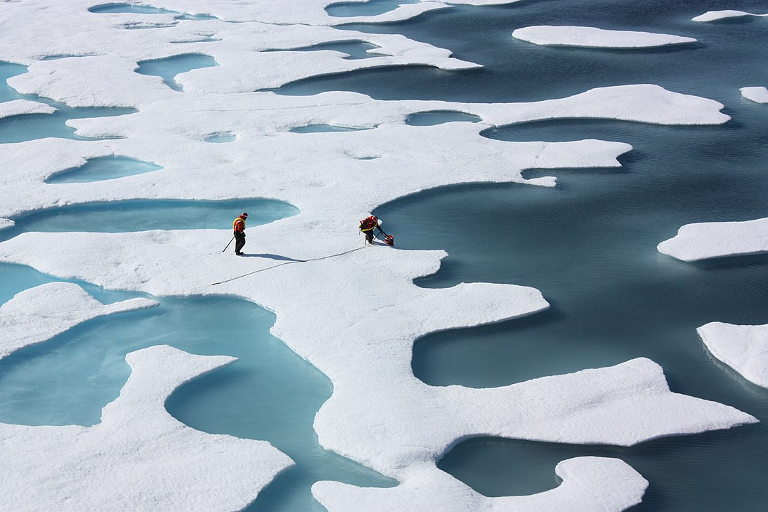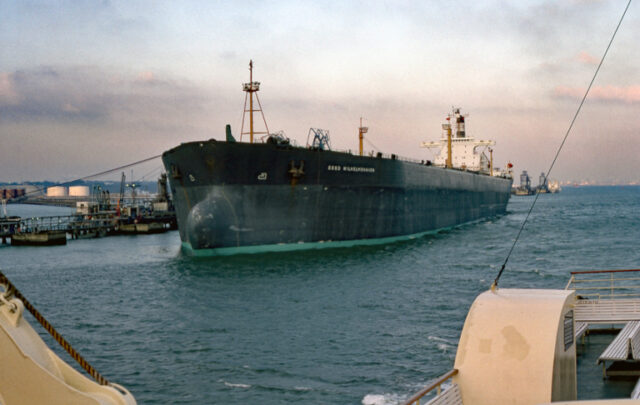The country of Iceland has held a funeral for its first glacier lost to the climate crisis. The once massive Okjökull glacier, now completely gone, has been commemorated with a plaque that reads: “A letter to the future. Ok is the first Icelandic glacier to lose its status as a glacier. In the next 200 years all our glaciers are expected to follow the same path. This monument is to acknowledge that we know what is happening and what needs to be done. Only you know if we did it.”
This reality is reverberating across the globe, far beyond Iceland. Even when no literal funeral is being held, we are, in a sense, witnessing an ongoing funeral for the world we once knew.
July was the hottest month ever recorded on Earth since record keeping began in 1880. Nine out of the 10 hottest Julys ever recorded have occurred since 2005, and July was the 43rd consecutive July to register temperatures above the 20th century average.
In Greenland, scientists were stunned by how rapidly the ice sheet is melting, as it was revealed the ice there was not expected to melt like this until 2070. The melt rate has been called “unprecedented,” as the all-time single-day melt record was broken in August as the ice sheet lost a mind-bending 12.5 billion tons of water in one day. It is worth remembering that the Greenland ice sheet contains enough ice to increase global sea levels by 20 feet, and it is now predicted that it will lose more ice this year than ever before.
Also for the first time in recorded history, Alaska’s sea ice has melted completely away. That means there was no sea ice whatsoever within 150 miles of its shores, according to the National Weather Service, as the northernmost state cooked under record-breaking heat through the summer.
Earth
A recent UN report estimates 2 billion people are already facing moderate to severe food insecurity, due largely to the warming planet. The other contributing factors are conflict and economic stagnation, but extreme weather events and shifting weather patterns are a large and growing contributor to this crisis, which is sure to escalate over time.
Another recent study, titled “Adaptive responses of animals to climate change are most likely insufficient,” showed that many animals are no longer able to adjust quickly enough to the climate crisis. While birds are laying their eggs earlier as temperatures and conditions change, and are doing what they can to coax their chicks to hatch sooner, it is still not enough to keep apace with the dramatically shifting climate. Many more extinctions are on the horizon.
Speaking of, Beluga whales in the Arctic are now clearly in a downward spiral toward their demise, due largely to climate crisis impacts, according to another study. Warming waters, lack of food, and pollution are taking their toll on the embattled whales. Over the past 20 years, their growth rates have been declining, which means their ability to forage for food is now also compromised.
It is interesting to see even mainstream outlets like People Magazine now reporting on climate grief, which the medical community has already been doing for quite some time, and expects to see a dramatic ramping up of climate-disruption-related mental health issues in the future.
In Greenland, residents are already traumatized by climate impacts, as they are coping with the reality that their traditional ways of life are clearly on the way out. Courtney Howard, board president of the Canadian Association of Physicians for the Environment, told The Guardian that she believes the climate crisis is causing worsening states of mental and physical health around the world, and says these issues will become some of the most important of our time. “Temperature change is magnified in circumpolar regions,” she told The Guardian. “There is no question Arctic people are now showing symptoms of anxiety, ‘ecological grief’ and even post-traumatic stress related to the effects of climate change.”
In the financial realms, a leading economic historian warned recently that the climate crisis could very well become the trigger for the next global financial crisis by way of causing instability and massive disruptions in markets.
Distressingly, a recently published study warned that a new superbug which erupted at the same time on three continents may well have been brought about from warming temperatures. The study pointed out how a drug-resistant fungal disease has now been made more prevalent by existing on a warming planet.
A recent report from Canada warned that British Columbia could see “catastrophic” consequences from climate disruption-related events in the next three decades. These include more severe wildfire seasons, increasingly intense and longer heat waves, water shortages, and storm surges across the province.
Speaking of Canada, that country’s Pediatric Society recently warned that children’s health is expected to be increasingly negatively affected by climate-disruption impacts, including things like air pollution and heat stress.
Water
Drought-induced blackouts are now besetting the people of Zimbabwe, where some places are seeing 18 hours per day without electricity. Imagine that in the summer heat. Dams providing hydropower lack water. Power blackouts are spreading.
In Harare, Zimbabwe’s capital city, the taps have run dry, affecting more than 2 million people, who have been trying to cope with not having access to municipal drinking water.
In India, a stunning 1 million people were displaced and at least 270 killed by severe flooding from heavier than usual monsoon rains.
Back in the U.S., New York City’s summer has served as a preview of things to come, as an extreme heat wave coupled with flash flooding beset the iconic city.
On the other end of the water spectrum, a recent study published in Science Advances warned that megadroughts will likely beset the U.S. Southwest within decades. The study stated that the megadroughts are “almost assured,” and will be on a scale not seen since medieval times.
At the same time, by 2050, another report warned that “snow droughts” will become far more common across the western U.S. This is critical, in that it compounds the aforementioned impending drought crisis, as mountain snowpack is vital to providing water into the spring and summer.
A recent and critically important study showed that one quarter of the total global population across 17 countries is already affected by extreme water stress. Lebanon, Qatar and Israel/Palestine top a list of places with the worst water shortages, as the growing climate crisis threatens more “day zeroes” — days where major cities will literally run out of water.
Meanwhile, sea levels continue their inevitable and accelerating rise. In the U.S., a recent report showed how 21 beach towns, including Miami Beach, Galveston, Atlantic City and Key West, will soon be underwater.
Speaking of Galveston, the state of Texas is looking toward Dutch expertise for assistance in how to construct what would be the nation’s most expensive and most ambitious coastal barrier for protection against intensifying hurricanes. The Netherlands has been devising ways to protect massive parts of its low-lying country against the ocean for centuries. Now the skills it has cultivated are, soberingly, increasingly relevant worldwide.
Meanwhile, the oceans continue to warm as they absorb the brunt of the heat human activity is adding to the atmosphere, and the warming waters are literally pushing Pacific salmon to the brink of their ability to survive, according to another report.
Distressingly, a recently published study showed that unexpected marine heat waves are now becoming the norm rather than the exception.
Alpine mountaineering routes are disintegrating as glaciers and icefields melt in the Alps. The ice-reliant climbing routes in the mountains are tumbling down and melting away faster than anyone expected.
Greenland experienced a record heat wave in the middle of this summer, which dramatically accelerated the melting of the ice sheet, meaning its contributions to sea level rise are in the process of accelerating as well..
Meanwhile, scientists have expressed alarm and shock about the fact that the permafrost across the Canadian Arctic is thawing out 70 years sooner than previously predicted.
Things are so dire in the icy realms of Earth that the country of Iceland is now preparing for how it will cope without any more ice … something that country relies upon for its identity, businesses, government and very existence.
Fire
These stunning satellite photos show an Arctic burning up in front of our eyes. In Alaska alone, at the time of this writing, at least 1.6 million acres have burned from at least 100 wildfires this summer. Wildfires in Siberia could well burn into October when the first snows fall, as at least 6.7 million acres have burned across Russia.
Another report showed that, due to climate disruption, wildfires in California have already become 500 percent larger than they were since the 1970s.
Canadian media are reporting that forests that have been scorched in the Pacific Northwest are not growing back as expected. This brings into question numerous species of trees’ ability to regenerate as the fires get increasingly hot, burn longer, and scorch longer areas.
At the same time, another report reaffirmed the fact that even the rainy Northwest is now facing the inevitable increased risk of wildfires due to higher temperatures, increasing drought and lower humidity.
Air
By 2050, Florida will have more days that feel like 100 degrees Fahrenheit (100°F) than any other state in the U.S., according to a recent study. Washington D.C. currently averages one week per year of 100-degree days, while by 2050 that could rise to two months. The same study warned that climate disruption will expose millions of people across the U.S. to “off-the-charts” extreme heat.
Meanwhile, Europe sizzled under a record-breaking heat wave this summer, as heat from the Sahara baked the continent and temperature records toppled en masse. There are far too many records to name from that heatwave, but notable was the fact that Germany, Belgium and The Netherlands recorded their highest temperatures ever during Europe’s second major summer heatwave.
In Canada, the far northern community of Nunavut saw warmer temperatures than the city of Victoria, far to its south. According to CBC News, “the source of the Arctic beach weather is a large current of air that somehow found its way north from the U.S. southeast” — a much more common occurrence as warming intensifies.
Denial and Reality
Ever busy denying the crisis, in the last month the Trump administration buried a large climate disruption response plan, as revealed by Politico. The outlet revealed how the Agriculture Department prevented the release of an already completed and sweeping plan about how the government should best respond to the climate crisis.
Meanwhile, in what could have been a slip of the tongue, Trump’s Energy Secretary Rick Perry said during a recent nationally televised interview, “The climate is changing. Are we part of the reason? Yeah, it is. I’ll let people debate on who’s the bigger problem here.”
It’s not just the Trump administration that’s fueling denial. It was also revealed how DNC Chair Tom Perez introduced a resolution in an attempt to kill a climate debate among the Democratic presidential candidates.
Nevertheless, reality has a way of not going away, despite human efforts at denial.
A recent report showed that the climate crisis is already well along in causing childhood deaths and the stunting of growth in Australia and across the Pacific. Other impacts on kids include lowered cognitive capacity and higher susceptibility to the spread of diseases.
And, to keep all of this in perspective, as a final reality check, the burning of fossil fuels reached an all-time record last year, according to oil giant BP.
For perspective on the rate of acceleration now baked into the system, half of all fossil fuels used by humans have been burned since just 1990. Many more consequences are lurking just around the corner: It takes at least 10 years before we begin to see the impacts of the CO2 once the fuels are burned.






